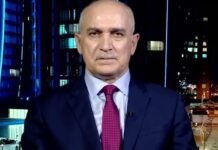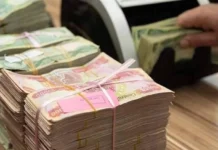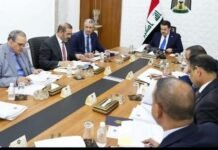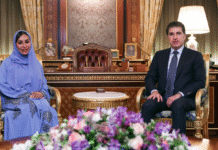Tishwash: Iraq’s trade with Iran is again confusing the dollar. Hantoush warns of a tight spot!
Economic expert Mustafa Hantoush confirmed that Iraq still has significant trade with Iran that is not covered by the official price, leading to continued pressure on the parallel market.
In a statement to Jarida Platform , Hantoush stated that “millions of travelers to Iran are also contributing to increased pressure on the parallel market. With the improvement of the Iranian currency thanks to negotiations with the United States and the reduction of remittances, this pressure has eased somewhat.”
He explained that “the Central Bank’s step to increase the limits on some cards has partially contributed to the solution, but the worsening situation and the return of remittances may push the parallel exchange rate up again.”
He added, “Iraq is now required to adopt new monetary policies to manage trade with Iran and passenger traffic. The solution may be through a tripartite account or a gold barter, as some countries in the region are doing, to extricate Iraq from this tight spot.” link
Tishwash: An economic expert told Al-Jarida Platform: The exchange rate is hostage to the political mood and regional shifts.
Economist Ahmed Hadhal spoke about the sensitivity of the dollar issue in Iraq and its direct impact on geopolitical and geoeconomic changes, emphasizing that the issue has become extremely complex internally and externally.
In an interview with Jarida Platform, Hathal stated that “since the end of 2022, and with the launch of the platform, the Central Bank has exhausted all monetary policy tools to address the gap between the parallel rate and the official rate. However, the problem is complex and does not only relate to the bank but also to the domestic market.” He explained that “60% of traders are still outside the platform, in addition to the lack of borders, which further complicates the crisis.”
He added that “the decline in the dollar’s value coincided with the failure to approve the general budget and the instability of some foreign negotiations. The exchange rate is linked to economic, political, and media factors, and is a highly sensitive indicator of any crisis, statement, or event.” He noted that “exchange rate fluctuations directly impact the purchasing power of citizens, merchants, companies, industrialists, importers, and even foreign investors.”
Hedhal explained that “the loss of trust between society and the government is one of the most significant factors driving demand for the dollar as a more stable and valuable currency, especially given the lack of real production within Iraq.
Oil production constitutes more than 70% of the GDP, and the general budget constitutes 190% of this GDP. These indicators raise concerns among citizens and investors about the possibility of a decline in the value of the dinar.”
He concluded by saying, “The exchange rate issue is linked to the psychological factors of citizens and investors, and there is a close relationship between behavioral economics and traditional economics, which makes currency stability necessitating addressing confidence in monetary and fiscal policies, ensuring their stability, and preventing sudden changes.” link
*****************
Tishwash: Oil rises, the dinar falls, and Baghdad faces the ramifications of Israeli-Iranian missiles.
Although it is outside the immediate circle of conflict, Iraq appears to be in the eye of the storm. Its geographical location, its near-total dependence on oil, and the peg of its economy to the dollar exchange rate make it vulnerable to every geopolitical shock in the region. While Israel and Iran exchange airstrikes and inflammatory statements, the Iraqi market translates these fires into tangible crises: rising food prices, a volatile dollar, and fears of a slowdown in the flow of goods through ports and borders.
As Israeli airstrikes on Iran escalated, the Iraqi dinar began to slide. This decline is not merely a technical result of changes in the currency markets; it is an expression of general panic and deep concern about political and security repercussions that Iraq may not be able to contain. Dealing with the US dollar is no longer just an economic issue; it has also become highly politically sensitive, especially with the US Treasury Department’s strict oversight of transfer and financing mechanisms within Iraq.
On Friday, following the unprecedented Israeli airstrikes on Iranian facilities, oil prices jumped nearly 5%, while the Iraqi dinar fell dramatically against the dollar, exceeding 146,000 dinars to $100 in some local markets, its lowest level in months.
Meanwhile, global oil markets are experiencing significant turmoil, with JP Morgan warning that oil prices could rise to $120 per barrel if geopolitical tensions in the Middle East escalate further.
Global oil prices rose, with Brent crude closing at $74.23, up 4.87%, while US crude also closed at $72.98, up 4.94%.
The dinar is the first to be affected
“What’s happening in Tehran is directly felt in the markets of Rusafa and Karkh,” says Ahmed Eid, an economic researcher, referring to the close relationship between regional stability and the status of the local currency.
“The sudden rise in the dollar price reflects a real state of panic, not only about the developments in the conflict, but also about its potential financial repercussions, especially if the United States resorts to tightening controls on transfers from the US Federal Reserve or imposing new banking restrictions,” he added in an interview with Shafaq News.
Eid warns that the continued smuggling of dollars from Iraq to Iran is fueling monetary instability, saying, “The Iraqi economy is dependent on external balance. We don’t produce; we buy everything from abroad, and with every tremor in the region, we are the first to suffer.”
Black gold: a temporary gain or an impending disaster?
At first glance, high oil prices appear to be an opportunity to boost Iraq’s treasury, especially given that more than 90% of its budget relies on crude oil revenues. However, recurring threats to energy corridors, most notably the Strait of Hormuz, reveal the fragility of this “profit.” Every additional barrel sold today may not find a safe route tomorrow. Worse still, proposed alternatives, such as the Turkish Ceyhan pipeline, provide only partial coverage, amid ongoing logistical and political challenges.
“This short-term profit does not hide the real danger,” says economic expert Safwan Qusay.
“Any threat to the Strait of Hormuz would mean that more than 3 million barrels of Iraqi oil per day would be at risk,” Qusay says. “Even if the Turkish Ceyhan pipeline were activated as an alternative route, it would cover only a third of exports, with burdensome logistical costs requiring thousands of trucks.”
Approximately one-fifth of the world’s oil trade—between 18 and 19 million barrels per day—passes through the Strait of Hormuz. Any military escalation affecting this vital artery would mean not only an Iraqi oil crisis, but also enormous pressure on prices and cash flows.
The indirect repercussions, however, appear more vague. The suspension of flights, the complexity of supply chains, and the potential displacement of Iranians or the return of Iraqi students and workers from Iran all add a new burden to the Iraqi state.
Financial expert Mahmoud Dagher told Shafaq News Agency that Iraq is still in the “economic resilience” phase, benefiting from high oil prices, but the door is open to more severe possibilities.
“The worst scenario is the closure of the straits, whether in the Arabian Gulf or the Red Sea, a card that Tehran or its allies in Yemen could play,” Dagher says, adding that “this would be an uncontainable blow, not only to the Baghdad government, but to the entire Middle Eastern economy.”
Iraq does not appear to have sufficient room for maneuver in this crisis. Between its near-total dependence on oil, weak domestic production, and the import of most basic commodities, any regional unrest becomes a daily matter for Iraqi citizens. As the crisis between Israel and Iran continues, attention is turning not only to the military fronts but also to the markets of Baghdad, where currencies, commodities, and fear determine the fate of millions.
In the absence of a real local production structure, the Iraqi economy is becoming something of a vehicle, completely linked to the regional locomotive. link





